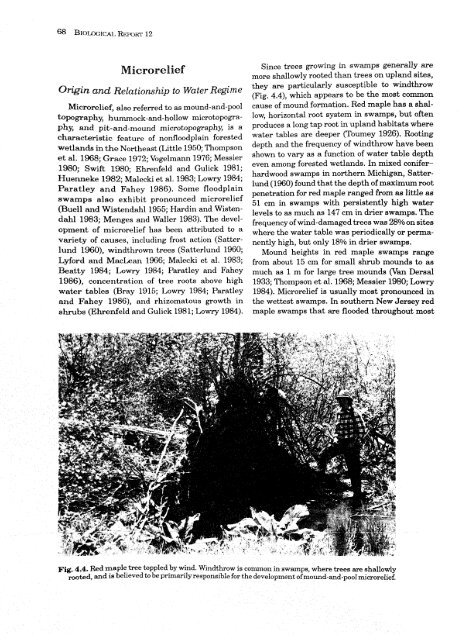Ecology of Red Maple Swamps in the Glaciated Northeast: A ...
Ecology of Red Maple Swamps in the Glaciated Northeast: A ...
Ecology of Red Maple Swamps in the Glaciated Northeast: A ...
You also want an ePaper? Increase the reach of your titles
YUMPU automatically turns print PDFs into web optimized ePapers that Google loves.
Orig<strong>in</strong>. an$ Relationship to Water Regime<br />
Microrelief, also referred to as mound-and-pool<br />
bpography, humock-and-hollow microtopgra-<br />
P ~ K and pit-and-rnaurtd microtopography, is a<br />
characteristic feature <strong>of</strong> nonfloodpla<strong>in</strong> forested<br />
wetlands <strong>in</strong> <strong>the</strong> Nor<strong>the</strong>ast (Tittle 19550; Thompson<br />
et al. 1968; G~ACO 1972; Vogelmann 1976; Messier<br />
1980; Swift 1980; Ehrenfeld and Gulick 1981;<br />
Huenneke 1982; Malecki et aI, 1983; Lowry 19M;<br />
Paratley and Fahey 1986). Some floodpla<strong>in</strong><br />
swamps also exhibit pronounced mieroreiief<br />
(Buell md Wistendahl 1955; Hard<strong>in</strong> and Wiatendahl<br />
1983; Menges and WaXler 1983). The development<br />
<strong>of</strong> microrelief has been attributed to a<br />
variety <strong>of</strong> causes, irrclud<strong>in</strong>g frost action (Satkrlund<br />
l%O), w<strong>in</strong>dthrown trees (Satterlund 1960;<br />
Lyford and MacI~txxi 1%; Malecki et al. 1983;<br />
Beatty 1984; TJowry 1984; EJaraLley and Fahey<br />
1986), concentration <strong>of</strong> tree roots above high<br />
water Lablea (Bray 1915; 1,owx-y 1984; Paratley<br />
and Fahey 198G), and ri~izomatous growth <strong>in</strong><br />
shbs (Ehrenfeld and Gtilick 1981; Lowry 1984).<br />
S<strong>in</strong>ce trees grow<strong>in</strong>g <strong>in</strong> swmps generally me<br />
more shallowly rooted than trees on upland sites,<br />
<strong>the</strong>y are particularly susceptible to w<strong>in</strong>dthrow<br />
Fig. 4.4), which appears ts be <strong>the</strong> most common<br />
cause <strong>of</strong> mound formation. <strong>Red</strong> maple has a shallow,<br />
horizontal root system <strong>in</strong> swamps, but <strong>of</strong>ten<br />
produces a long tap root <strong>in</strong> upland habitats where<br />
water tables are deeper (Toumey 1926). Root<strong>in</strong>g<br />
depth and <strong>the</strong> frequency <strong>of</strong> w<strong>in</strong>dthrow have been<br />
shown to vary as a function <strong>of</strong> water table depth<br />
even among forested wetlands. In mixed coniferhardwood<br />
swamps <strong>in</strong> nor<strong>the</strong>rn Michigan, Satterlmd<br />
(1960) found that <strong>the</strong> depth <strong>of</strong> maximum root<br />
penetration for red maple ranged from as little as<br />
51 cm <strong>in</strong> swamps with persistently high water<br />
levels to as much as 147 cm <strong>in</strong> drier swamps. The<br />
frequency <strong>of</strong> w<strong>in</strong>d-damaged trees was 28% on sites<br />
where <strong>the</strong> water table was periodically or permanentiy<br />
high, but only 18% <strong>in</strong> drier swamps.<br />
Mound heights <strong>in</strong> red maple swamps range<br />
from about 15 cm for small shrub mounds to as<br />
much as 1 m for large tree mounds (Van Dersal<br />
1933; Thompson et al. 1968; Messier 1980; Lowry<br />
1984). Microrelief is usually most pronounced <strong>in</strong><br />
<strong>the</strong> wettest swamps. In sou<strong>the</strong>rn New Jersey red<br />
maple swamps that are flooded throughout most<br />
Fjg. 4.4. <strong>Red</strong> maple tree toppled by w<strong>in</strong>d. W<strong>in</strong>dthrow is common <strong>in</strong> swamps, where trees are shallowly<br />
-*a, is believed to be primarily responsible for <strong>the</strong> development <strong>of</strong>mound-and-pol ~crorelief.

















